The Construction of a Hydrophilic Inorganic Layer Enables Mechanochemically Robust Super Antifouling UHMWPE Composite Membrane Surfaces
Abstract
1. Introduction
2. Experimental
2.1. Materials
2.2. Synthesis of Inorganic Hydrophilic Surface Composite Membrane
2.3. Characterization of Inorganic Hydrophilic Surface Composite Membrane
2.4. Membrane Permeation Performance Evaluation
2.5. Antifouling Performance Evaluation
3. Results and Discussion
3.1. Characterization of Surface Physicochemical Properties of Modified Composite Membranes
3.2. Separation Performance
3.3. Antifouling Performance
4. Conclusions
Author Contributions
Funding
Conflicts of Interest
References
- Sharma, P.R.; Joshi, R.; Sharma, S.K.; Hsiao, B.S. A simple approach to prepare carboxycellulose nanofibers from untreated biomass. Biomacromolecules 2017, 18, 2333–2342. [Google Scholar] [CrossRef] [PubMed]
- Sharma, P.R.; Chattopadhyay, A.; Sharma, S.K.; Hsiao, B.S. Efficient removal of uo22+ from water using carboxycellulose nanofibers prepared by the nitro-oxidation method. Ind. Eng. Chem. Res. 2017, 56, 13885–13893. [Google Scholar] [CrossRef]
- Chen, H.; Sharma, S.K.; Sharma, P.R.; Yeh, H.; Johnson, K.; Hsiao, B.S. Arsenic (iii) removal by nanostructured dialdehyde cellulose–cysteine microscale and nanoscale fibers. ACS Omega 2019, 4. [Google Scholar] [CrossRef] [PubMed]
- Zhan, C.; Li, Y.; Sharma, P.R.; He, H.; Sharma, S.K.; Wang, R.; Hsiao, B.S. A study of tio 2 nanocrystal growth and environmental remediation capability of TiO2/CnC nanocomposites. RSC Adv. 2019, 9, 40565–40576. [Google Scholar] [CrossRef]
- Sharma, P.R.; Sharma, S.K.; Antoine, R.; Hsiao, B.S. Efficient removal of arsenic using zinc oxide nanocrystal-decorated regenerated microfibrillated cellulose scaffolds. ACS Sustain. Chem. Eng. 2019, 7, 6140–6151. [Google Scholar] [CrossRef]
- Sharma, P.R.; Chattopadhyay, A.; Sharma, S.K.; Geng, L.; Amiralian, N.; Martin, D.; Hsiao, B.S. Nanocellulose from spinifex as an effective adsorbent to remove cadmium (ii) from water. ACS Sustain. Chem. Eng. 2018, 6, 3279–3290. [Google Scholar] [CrossRef]
- Liu, R.; Wang, X.W.; Yu, J.R.; Wang, Y.; Zhu, J.; Hu, Z.M. Development and evaluation of uhmwpe/woven fabric composite microfiltration membranes via thermally induced phase separation. RSC Adv. 2016, 6, 90701–90710. [Google Scholar] [CrossRef]
- Meola, C.; Giorleo, G.; Prisco, U. Experimental evaluation of properties of cross-linked polyethylene. Mater. Manuf. Process. 2003, 18, 135–144. [Google Scholar] [CrossRef]
- Sun, C.; Feng, X. Enhancing the performance of pvdf membranes by hydrophilic surface modification via amine treatment. Sep. Purif. Technol. 2017, 185, 94–102. [Google Scholar] [CrossRef]
- Chen, X.; He, Y.; Fan, Y.; Zeng, G.; Zhang, L. Nature-inspired polyphenol chemistry to fabricate halloysite nanotubes decorated pvdf membrane for the removal of wastewater. Sep. Purif. Technol. 2019, 212, 326–336. [Google Scholar] [CrossRef]
- Razali, M.; Didaskalou, C.; Kim, J.F.; Babaei, M.; Drioli, E.; Lee, Y.M.; Szekely, G. Exploring and exploiting the effect of solvent treatment in membrane separations. ACS Appl. Mater. Intfaces 2017, 9, 11279–11289. [Google Scholar] [CrossRef] [PubMed]
- Ignacz, G.; Fei, F.; Szekely, G. Ion-stabilized membranes for demanding environments fabricated from polybenzimidazole and its blends with polymers of intrinsic microporosity. ACS Appl. Nano Mater. 2018, 1, 6349–6356. [Google Scholar] [CrossRef]
- Olivier, A.; Meyer, F.; Raquez, J.M.; Damman, P.; Dubois, P. Surface-initiated controlled polymerization as a convenient method for designing functional polymer brushes: From self-assembled monolayers to patterned surfaces. Prog. Polym. Sci. 2012, 37, 157–181. [Google Scholar] [CrossRef]
- Jiang, J.H.; Zhu, L.P.; Li, X.L.; Xu, Y.Y.; Zhu, B.K. Surface modification of pe porous membranes based on the strong adhesion of polydopamine and covalent immobilization of heparin. J. Membr. Sci. 2010, 364, 194–202. [Google Scholar] [CrossRef]
- Zhu, C.H.; Shi, J.; Xu, S.J.; Ishimori, M.; Sui, J.H.; Morikawa, H. Design and characterization of self-cleaning cotton fabrics exploiting zinc oxide nanoparticle-triggered photocatalytic degradation. Cellulose 2017, 24, 2657–2667. [Google Scholar] [CrossRef]
- Zhang, Y.; Jiang, Z.; Huang, J.; Lim, L.Y.; Li, W.; Deng, J.; Gong, D.; Tang, Y.; Lai, Y.; Chen, Z. Titanate and titania nanostructured materials for environmental and energy applications: A review. RSC Adv. 2015, 5, 79479–79510. [Google Scholar] [CrossRef]
- Banerjee, I.; Pangule, R.C.; Kane, R.S. Antifouling coatings: Recent developments in the design of surfaces that prevent fouling by proteins, bacteria, and marine organisms. Adv. Mater. 2011, 23, 690–718. [Google Scholar] [CrossRef]
- Chen, W.J.; Su, Y.L.; Peng, J.M.; Zhao, X.T.; Jiang, Z.Y.; Dong, Y.A.; Zhang, Y.; Liang, Y.G.; Liu, J.Z. Efficient wastewater treatment by membranes through constructing tunable antifouling membrane surfaces. Environ. Sci. Technol. 2011, 45, 6545–6552. [Google Scholar] [CrossRef]
- Kobayashi, M.; Terayama, Y.; Yamaguchi, H.; Terada, M.; Murakami, D.; Ishihara, K.; Takahara, A. Wettability and antifouling behavior on the surfaces of superhydrophilic polymer brushes. Langmuir 2012, 28, 7212–7222. [Google Scholar] [CrossRef]
- Shao, L.; Wang, Z.X.; Zhang, Y.L.; Jiang, Z.X.; Liu, Y.Y. A facile strategy to enhance pvdf ultrafiltration membrane performance via self-polymerized polydopamine followed by hydrolysis of ammonium fluotitanate. J. Membr. Sci. 2014, 461, 10–21. [Google Scholar] [CrossRef]
- Zhao, X.Z.; Xuan, H.X.; Chen, Y.L.; He, C.J. Preparation and characterization of superior antifouling pvdf membrane with extremely ordered and hydrophilic surface layer. J. Membr. Sci. 2015, 494, 48–56. [Google Scholar] [CrossRef]
- Rahimpour, A.; Madaeni, S.S.; Taheri, A.H.; Mansourpanah, Y. Coupling tio2 nanoparticles with uv irradiation for modification of polyethersulfone ultrafiltration membranes. J. Membr. Sci. 2008, 313, 158–169. [Google Scholar] [CrossRef]
- Xie, Y.J.; Hill, C.A.S.; Xiao, Z.F.; Militz, H.; Mai, C. Silane coupling agents used for natural fiber/polymer composites: A review. Compos. Part A Appl. Sci. Manuf. 2010, 41, 806–819. [Google Scholar] [CrossRef]
- Kango, S.; Kalia, S.; Celli, A.; Njuguna, J.; Habibi, Y.; Kumar, R. Surface modification of inorganic nanoparticles for development of organic-inorganic nanocomposites-a review. Prog. Polym. Sci. 2013, 38, 1232–1261. [Google Scholar] [CrossRef]
- Wu, J.B.; Ling, L.X.; Xie, J.B.; Ma, G.Z.; Wang, B.J. Surface modification of nanosilica with 3-mercaptopropyl trimethoxysilane: Experimental and theoretical study on the surface interaction. Chem. Phys. Lett. 2014, 591, 227–232. [Google Scholar] [CrossRef]
- Zhou, H.; Su, Y.; Chen, X.; Yi, S.; Wan, Y. Modification of silicalite-1 by vinyltrimethoxysilane (vtms) and preparation of silicalite-1 filled polydimethylsiloxane (pdms) hybrid pervaporation membranes. Sep. Purif. Technol. 2010, 75, 286–294. [Google Scholar] [CrossRef]
- Fernández, L.G.; Cravero, F.; Sánchez, M.P.; De la Cruz Vivanco, C.; Gattia, M. Synthesis and characterization of vinyltrimethoxysilane-grafted non-swelling clay. Procedia Mater. Sci. 2015, 8, 414–423. [Google Scholar] [CrossRef]
- Hou, D.; Christie, K.S.; Wang, K.; Tang, M.; Wang, D.; Wang, J. Biomimetic superhydrophobic membrane for membrane distillation with robust wetting and fouling resistance. J. Membr. Sci. 2019, 599, 117708. [Google Scholar] [CrossRef]
- Liu, S.; Zhou, C.; Yu, W. Phase separation and structure control in ultra-high molecular weight polyethylene microporous membrane. J. Membr. Sci. 2011, 379, 268–278. [Google Scholar] [CrossRef]
- Xin, Z.; Hou, J.; Ding, J.; Yang, Z.; Yan, S.; Liu, C. Surface functionalization of polyethylene via covalent immobilization of o-stearoyl-chitosan. Appl. Surf. Sci. 2013, 279, 424–431. [Google Scholar] [CrossRef]
- Zhou, Y.; Yu, J.; Wang, X.; Wang, Y.; Zhu, J.; Hu, Z. Preparation of KH570-SiO2 and their modification on the MF/PVA composite membrane. Fibers Polym. 2015, 16, 1772–1780. [Google Scholar] [CrossRef]
- Park, J.J.; Lee, J.Y.; Lee, H.K. Surface modification of nanosilica with epoxy-terminated silicone and its effect on the electrical breakdown strength in epoxy/nanosilica nanocomposite. J. Nanosci. Nanotechnol. 2017, 17, 7598–7602. [Google Scholar] [CrossRef]
- Iyer, K.A.; Torkelson, J.M. Importance of superior dispersion versus filler surface modification in producing robust polymer nanocomposites: The example of polypropylene/nanosilica hybrids. Polymer 2015, 68, 147–157. [Google Scholar] [CrossRef]
- Zhao, X.; Xuan, H.; Qin, A.; Liu, D.; He, C. Improved antifouling property of pvdf ultrafiltration membrane with plasma treated pvdf powder. RSC Adv. 2015, 5, 64526–64533. [Google Scholar] [CrossRef]
- Guo, H.; Geng, C.; Qin, Z.; Chen, C. Hydrophilic modification of hdpe microfiltration membrane by corona-induced graft polymerization. Desalin. Water Treat. 2013, 51, 3810–3813. [Google Scholar] [CrossRef]
- Zhao, X.; Liu, C. One-step fabricated bionic pvdf ultrafiltration membranes exhibiting innovative antifouling ability to the cake fouling. J. Membr. Sci 2016, 515, 29–35. [Google Scholar] [CrossRef]
- Liu, D.; Li, D.; Du, D.; Zhao, X.; Qin, A.; Li, X.; He, C. Antifouling pvdf membrane with hydrophilic surface of terry pile-like structure. J. Membr. Sci. 2015, 493, 243–251. [Google Scholar] [CrossRef]
- Zhang, W.; Zhao, X.; Zhang, Z.; Xu, Y.; Wang, X. Preparation of poly(vinyl alcohol)-based membranes with controllable surface composition and bulk structures and their pervaporation performance. J. Membr. Sci. 2012, 415–416, 504–512. [Google Scholar] [CrossRef]
- Zhou, Q.; Li, J.H.; Yan, B.F.; Wu, D.; Zhang, Q.Q. Thermo-responsive and antifouling pvdf nanocomposited membranes based on pnipaam modified tio2 nanoparticles. Chin. J. Polym. Sci. 2014, 32, 892–905. [Google Scholar] [CrossRef]
- Jiao, C.; Wang, Z.; Gui, Z.; Hu, Y. Silane grafting and crosslinking of ethylene–octene copolymer. Eur. Polym. J. 2005, 41, 1204–1211. [Google Scholar] [CrossRef]
- Pollet, P.; Liotta, C.L.; Eckert, C.A.; Verma, M.; Nixon, E.; Sivaswamy, S.; Jha, R.; Momin, F.; Gelbaum, L.; Chaudhary, B.I. Radical-mediated graft modification of polyethylene models with vinyltrimethoxysilane: A fundamental study. Ind. Eng. Chem. Res. 2011, 50, 12246–12253. [Google Scholar] [CrossRef]
- Lim, M.; Kim, D.; Seo, J.; Han, H. Preparation and properties of poly(vinyl alcohol)/vinyltrimethoxysilane (pva/vtms) hybrid films with enhanced thermal stability and oxygen barrier properties. Macromol. Res. 2014, 22, 1096–1103. [Google Scholar] [CrossRef]
- Lu, X.L.; Castrillon, S.R.V.; Shaffer, D.L.; Ma, J.; Elimelech, M. In situ surface chemical modification of thin-film composite forward osmosis membranes for enhanced organic fouling resistance. Environ. Sci. Technol. 2013, 47, 12219–12228. [Google Scholar] [CrossRef] [PubMed]
- Tiraferri, A.; Kang, Y.; Giannelis, E.P.; Elimelech, M. Highly hydrophilic thin-film composite forward osmosis membranes functionalized with surface-tailored nanoparticles. ACS Appl. Mater. Interfaces 2012, 4, 5044–5053. [Google Scholar] [CrossRef] [PubMed]
- Ghanbari, M.; Emadzadeh, D.; Lau, W.J.; Matsuura, T.; Davoody, M.; Ismail, A.F. Super hydrophilic TiO2/HNT nanocomposites as a new approach for fabrication of high performance thin film nanocomposite membranes for FO application. Desalination 2015, 371, 104–114. [Google Scholar] [CrossRef]
- Zhang, R.N.; Liu, Y.N.; He, M.R.; Su, Y.L.; Zhao, X.T.; Elimelech, M.; Jiang, Z.Y. Antifouling membranes for sustainable water purification: Strategies and mechanisms. Chem. Soc. Rev. 2016, 45, 5888–5924. [Google Scholar] [CrossRef]
- Mi, B.; Elimelech, M. Chemical and physical aspects of organic fouling of forward osmosis membranes. J. Membr. Sci. 2008, 320, 292–302. [Google Scholar] [CrossRef]
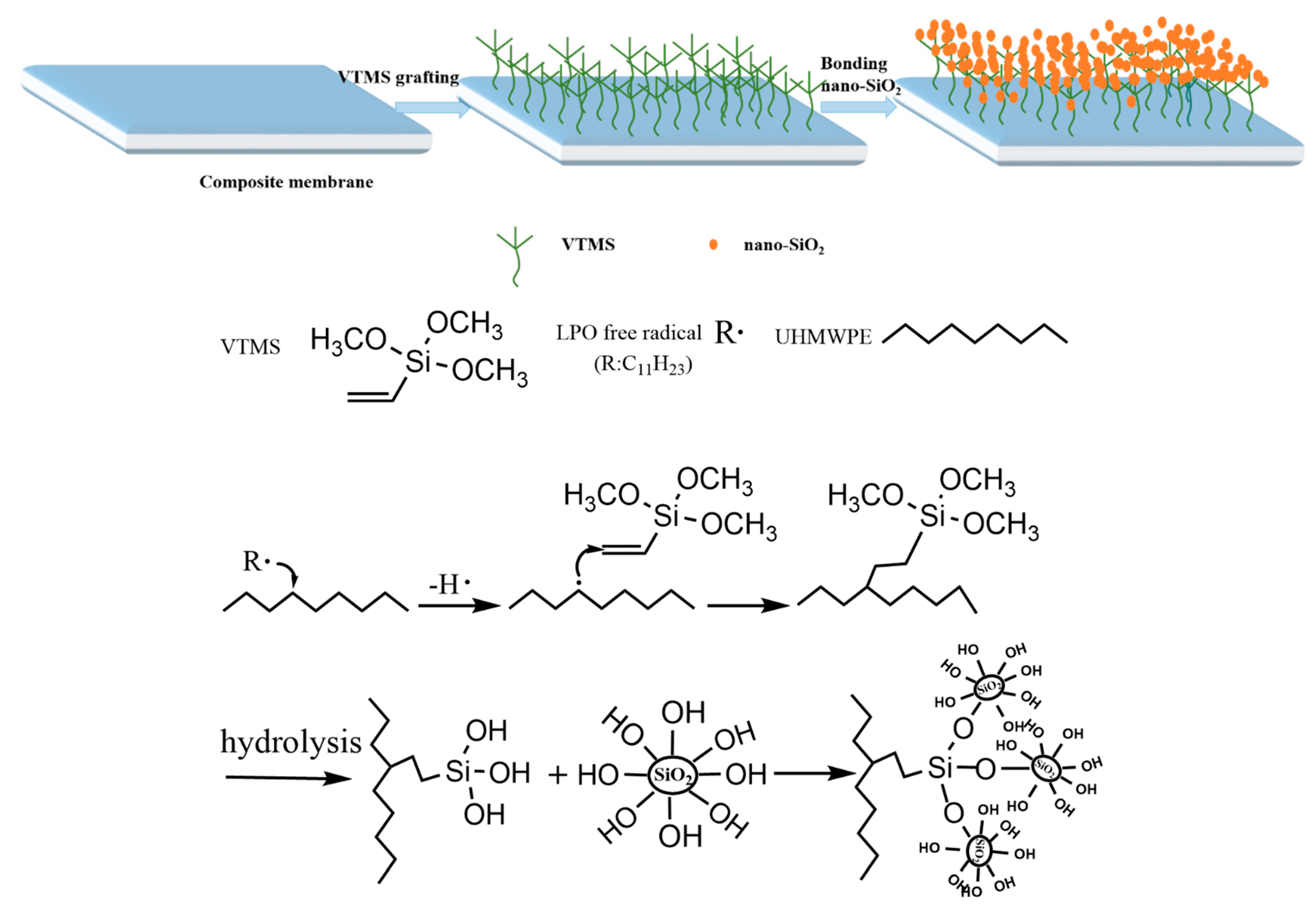

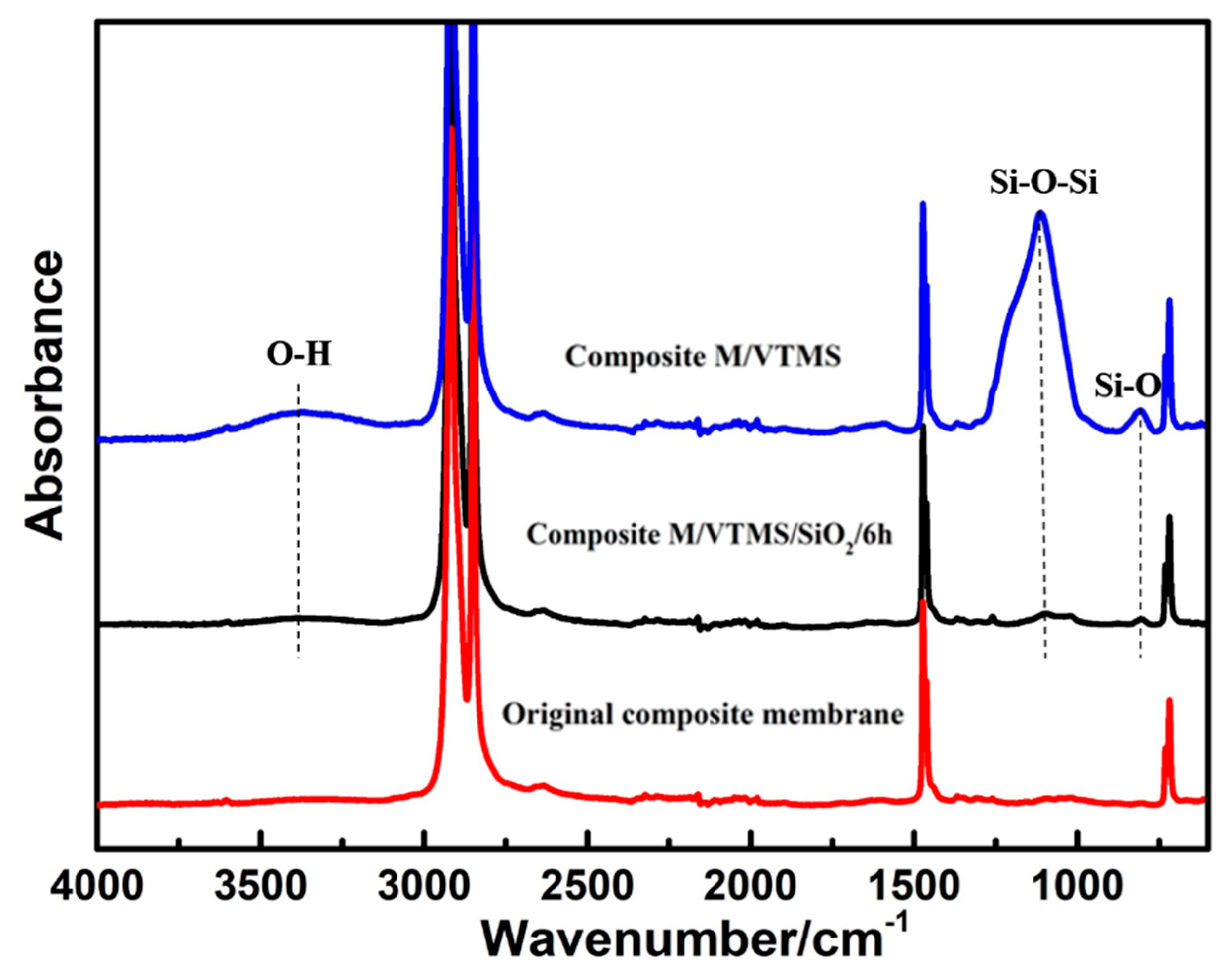
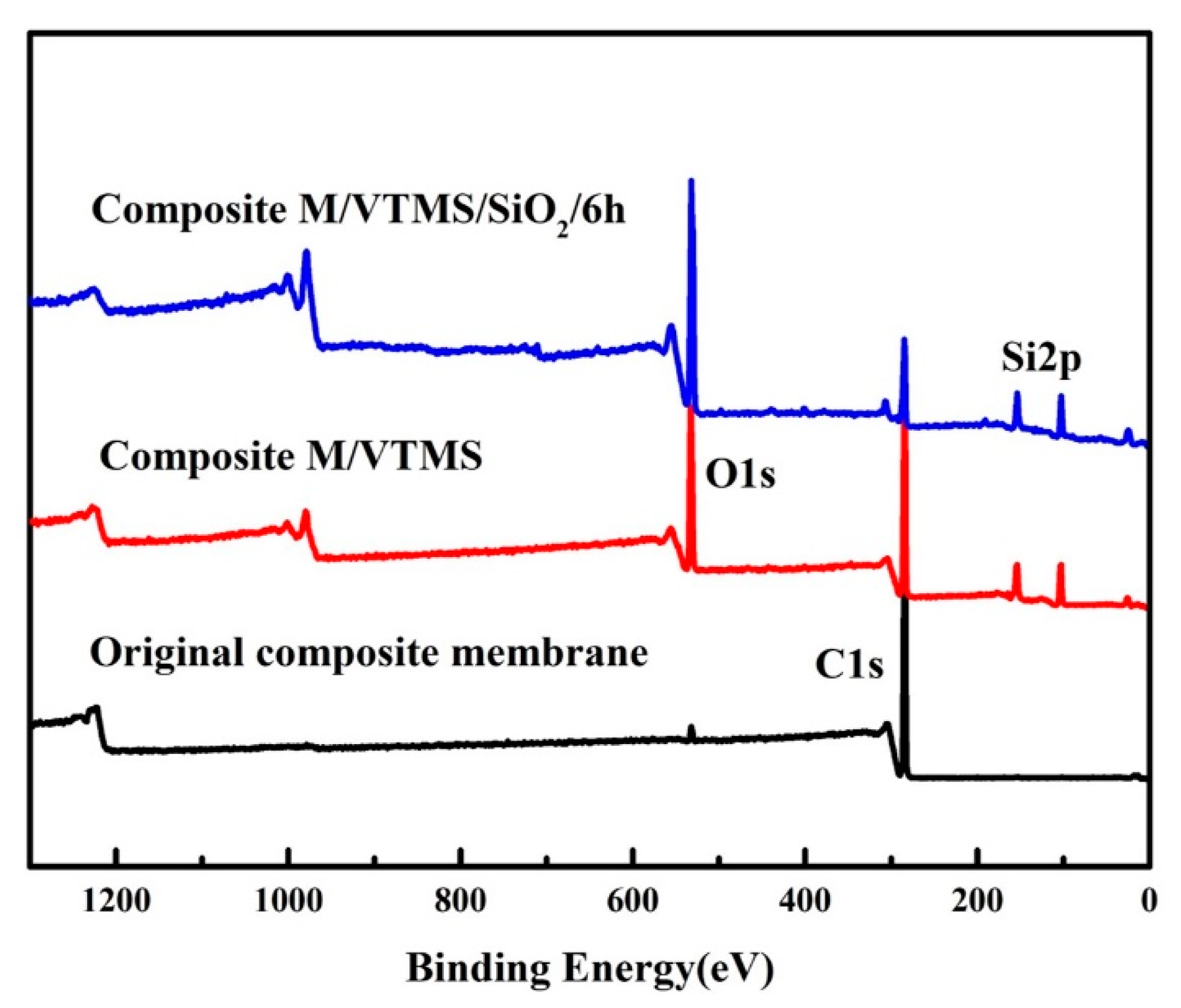

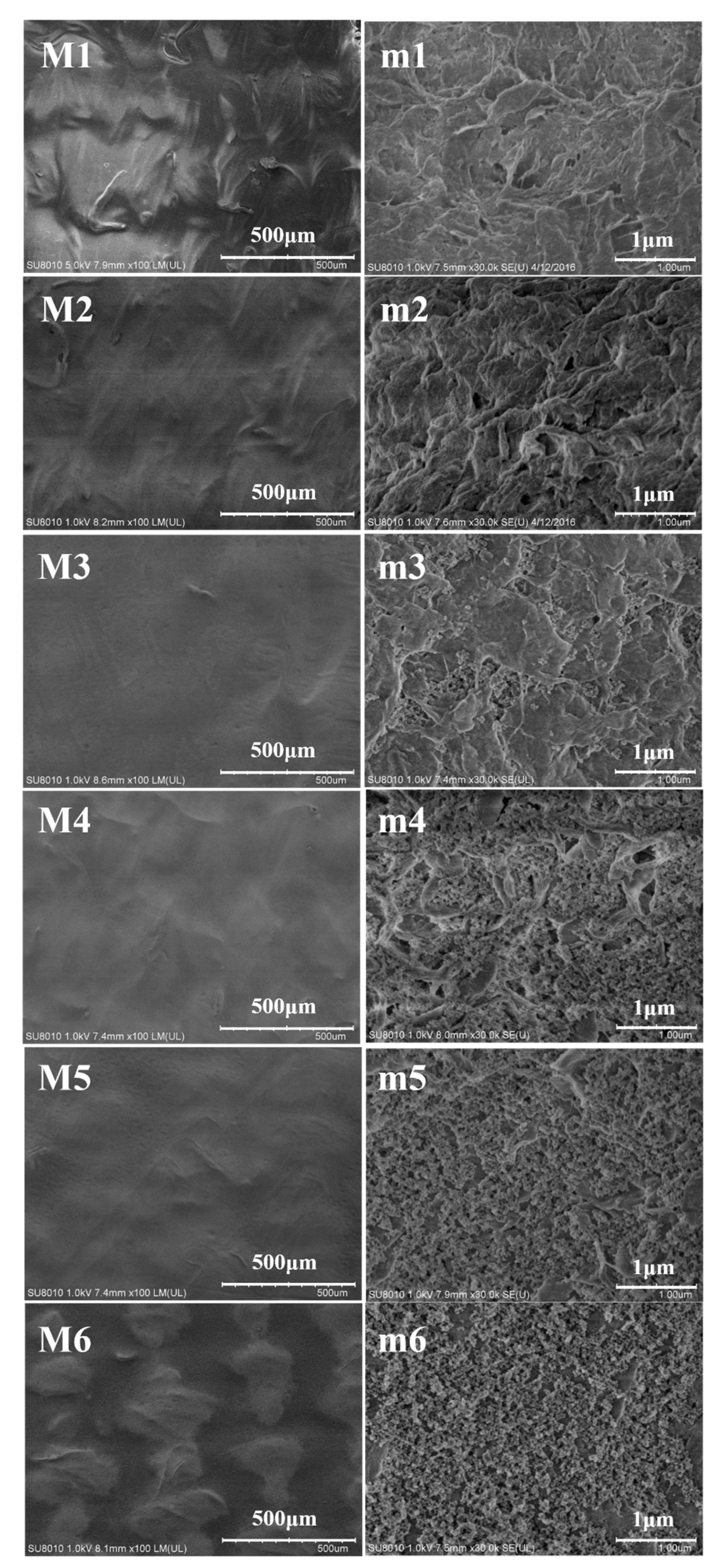
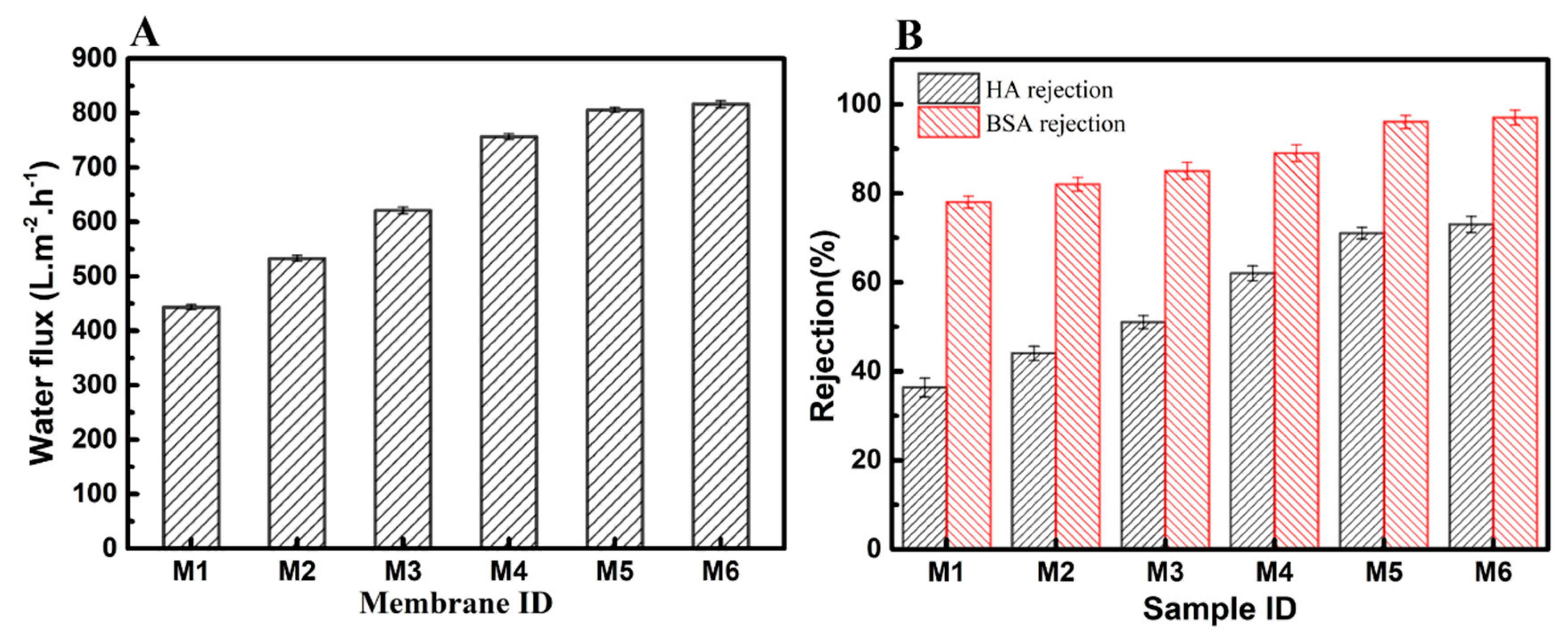

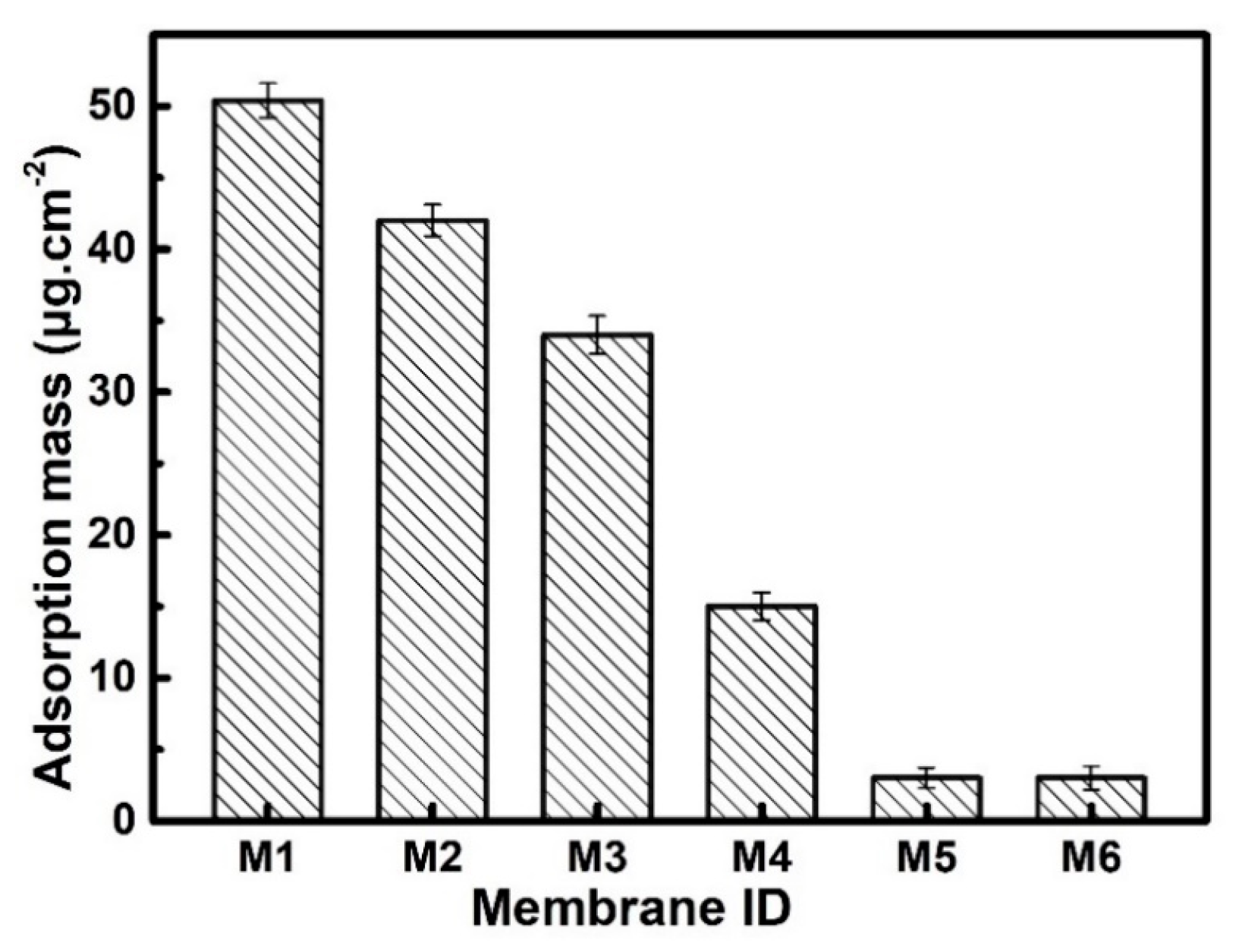
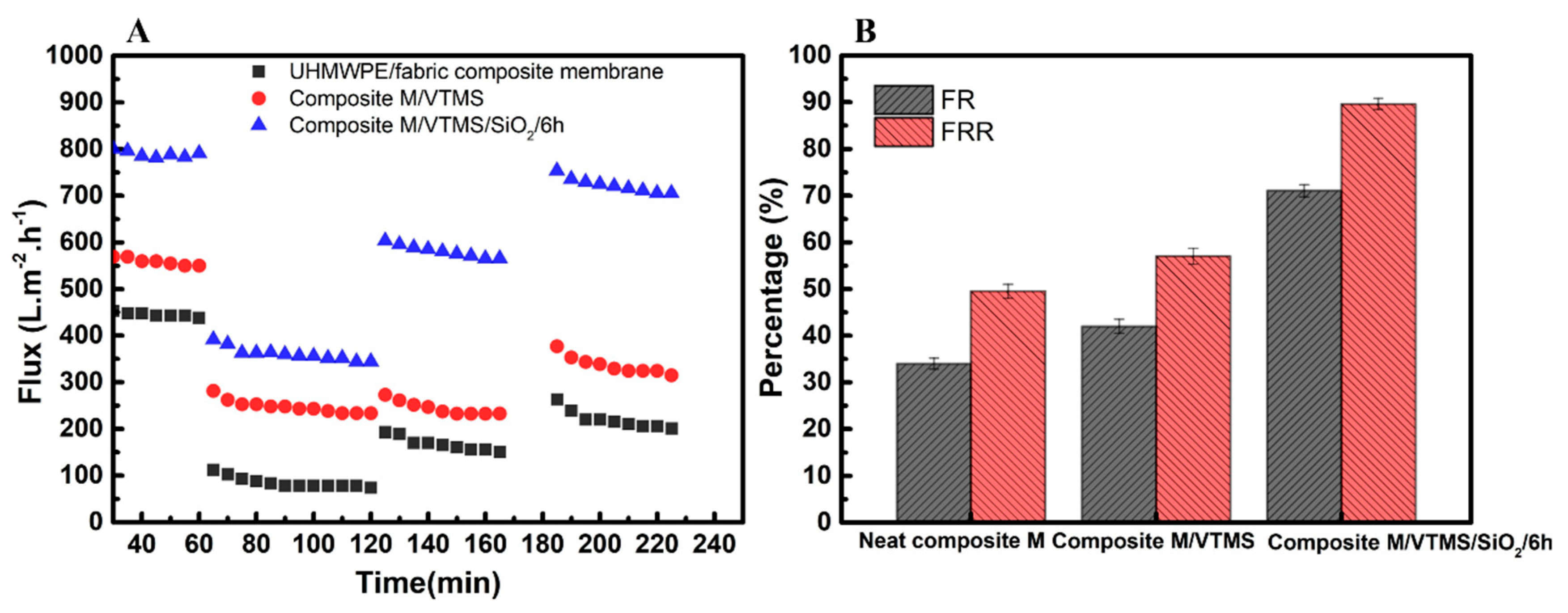

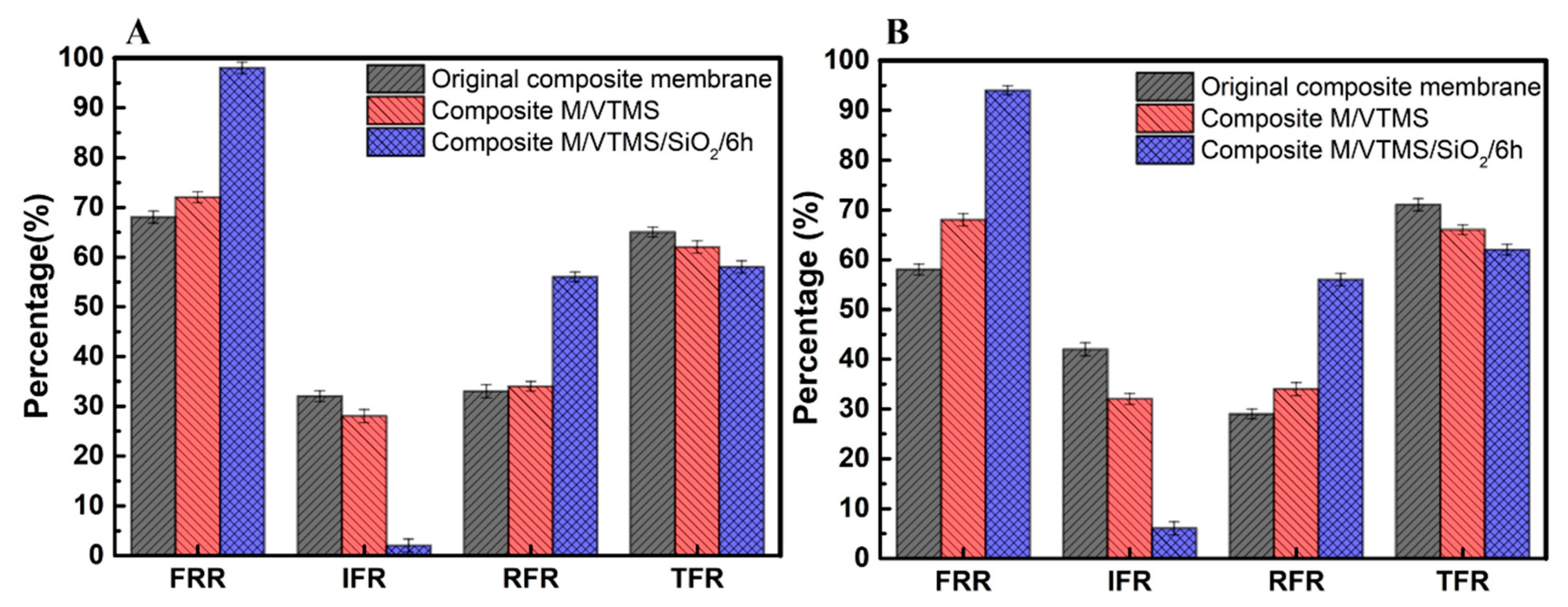
| Code | Membrane | Coating Time | |
|---|---|---|---|
| Step 1 Grafting VTMS (h) | Step 2 nano-SiO2 (h) | ||
| M1 | Composite M | 0 | 0 |
| M2 | Composite M/VTMS | 4 | 0 |
| M3 | Composite M/VTMS/SiO2/1.5 | 4 | 1.5 |
| M4 | Composite M/VTMS/SiO2/3 | 4 | 3 |
| M5 | Composite M/VTMS/SiO2/6 | 4 | 6 |
| M6 | Composite M/VTMS/SiO2/8 | 4 | 8 |
| Sample | C1s (%) | O1s (%) | Si2p (%) |
|---|---|---|---|
| Original composite membrane | 97.71 | 1.91 | 0.4 |
| Composite M/VTMS | 61.09 | 26.04 | 12.25 |
| Composite M/VTMS/SiO2/6 | 40.39 | 35.38 | 24.23 |
| Membrane | Modification Method | Contact Angle | BSA FRR | Ref |
|---|---|---|---|---|
| PVDF | Self-polymerized polydopamine and subsequent hydrolysis of TiO2 | 48° | 90% | [20] |
| PVDF | Plasma treatment | 33.2° | 99% | [21] |
| PES ultrafiltration membranes | Coupling TiO2 nanoparticles with UV irradiation | 53.5° | 79% | [22] |
| UHMWPE/fabric composite M | Chemical grafting | 43° | 93% | Author’s |
© 2020 by the authors. Licensee MDPI, Basel, Switzerland. This article is an open access article distributed under the terms and conditions of the Creative Commons Attribution (CC BY) license (http://creativecommons.org/licenses/by/4.0/).
Share and Cite
Liu, R.; Liu, S.; Yu, J.; Zhang, W.; Dai, J.; Zhang, Y.; Zhang, G. The Construction of a Hydrophilic Inorganic Layer Enables Mechanochemically Robust Super Antifouling UHMWPE Composite Membrane Surfaces. Polymers 2020, 12, 569. https://doi.org/10.3390/polym12030569
Liu R, Liu S, Yu J, Zhang W, Dai J, Zhang Y, Zhang G. The Construction of a Hydrophilic Inorganic Layer Enables Mechanochemically Robust Super Antifouling UHMWPE Composite Membrane Surfaces. Polymers. 2020; 12(3):569. https://doi.org/10.3390/polym12030569
Chicago/Turabian StyleLiu, Rong, Shusen Liu, Junrong Yu, Wei Zhang, Jiamu Dai, Yu Zhang, and Guangyu Zhang. 2020. "The Construction of a Hydrophilic Inorganic Layer Enables Mechanochemically Robust Super Antifouling UHMWPE Composite Membrane Surfaces" Polymers 12, no. 3: 569. https://doi.org/10.3390/polym12030569
APA StyleLiu, R., Liu, S., Yu, J., Zhang, W., Dai, J., Zhang, Y., & Zhang, G. (2020). The Construction of a Hydrophilic Inorganic Layer Enables Mechanochemically Robust Super Antifouling UHMWPE Composite Membrane Surfaces. Polymers, 12(3), 569. https://doi.org/10.3390/polym12030569





